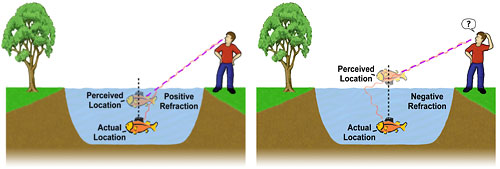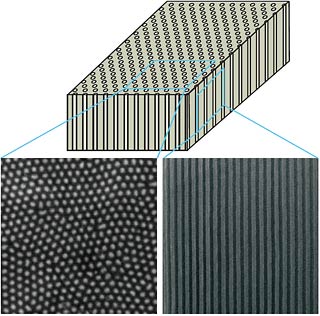UC Berkeley Press Release
 An illustration of how a fish in water is seen by an observer, with the red lines marking the refraction of light and the purple lines representing the path towards the perceived location of the fish, which appears above its actual location. |
Invisibility shields one step closer with new metamaterials that bend light backwards
BERKELEY – Scientists at the University of California, Berkeley, have for the first time engineered 3-D materials that can reverse the natural direction of visible and near-infrared light, a development that could help form the basis for higher resolution optical imaging, nanocircuits for high-powered computers, and, to the delight of science-fiction and fantasy buffs, cloaking devices that could render objects invisible to the human eye.
Two breakthroughs in the development of metamaterials - composite materials with extraordinary capabilities to bend electromagnetic waves - are reported separately this week in the Aug. 13 advanced online issue of Nature, and in the Aug. 15 issue of Science.
 Above is a schematic of the first 3-D "fishnet" metamaterial that can achieve a negative index of refraction at optical frequencies. Below is a scanning electron microscope image of the fabricated structure, developed by UC Berkeley researchers. The alternating layers form small circuits that can bend light backwards. (Jason Valentine/UC Berkeley)  |
The common thread in such metamaterials is negative refraction. In contrast, all materials found in nature have a positive refractive index, a measure of how much electromagnetic waves are bent when moving from one medium to another.
In a classic illustration of how refraction works, the submerged part of a pole inserted into water will appear as if it is bent up towards the water's surface. If water exhibited negative refraction, the submerged portion of the pole would instead appear to jut out from the water's surface. Or, to give another example, a fish swimming underwater would instead appear to be moving in the air above the water's surface.
Other research teams have previously developed metamaterials that function at optical frequencies, but those 2-D materials have been limited to a single monolayer of artificial atoms whose light-bending properties cannot be defined. Thicker, 3-D metamaterials with negative refraction have only been reported at longer microwave wavelengths.
"What we have done is take two very different approaches to the challenge of creating bulk metamaterials that can exhibit negative refraction in optical frequencies," said Xiang Zhang, professor at UC Berkeley's Nanoscale Science and Engineering Center, funded by the National Science Foundation (NSF), and head of the research teams that developed the two new metamaterials. "Both bring us a major step closer to the development of practical applications for metamaterials."
Zhang is also a faculty scientist in the Material Sciences Division at the Lawrence Berkeley National Laboratory.
Humans view the world through the narrow band of electromagnetic radiation known as visible light, with wavelengths ranging from 400 nanometers (violet and purple light), to 700 nanometers (deep red light). Infrared light wavelengths are longer, measuring from about 750 nanometers to 1 millimeter. (A human hair is about 100,000 nanometers in diameter.)
For a metamaterial to achieve negative refraction, its structural array must be smaller than the electromagnetic wavelength being used. Not surprisingly, there has been more success in manipulating wavelengths in the longer microwave band, which can measure 1 millimeter up to 30 centimeters long.
In the Nature paper, the UC Berkeley researchers stacked together alternating layers of silver and non-conducting magnesium fluoride, and cut nanoscale-sized fishnet patterns into the layers to create a bulk optical metamaterial. At wavelengths as short as 1500 nanometers, the near-infrared light range, researchers measured a negative index of refraction.
Jason Valentine, UC Berkeley graduate student and co-lead author of the Nature paper, explained that each pair of conducting and non-conducting layers forms a circuit, or current loop. Stacking the alternating layers together creates a series of circuits that respond together in opposition to that of the magnetic field from the incoming light.
Valentine also noted that both materials achieve negative refraction while minimizing the amount of energy that is absorbed or "lost" as light passes through them. In the case of the "fishnet" material described in Nature, the strongly interacting nanocircuits allow the light to pass through the material and expend less energy moving through the metal layers.
"Natural materials do not respond to the magnetic field of light, but the metamaterial we created here does," said Valentine. "It is the first bulk material that can be described as having optical magnetism, so both the electrical and magnetic fields in a light wave move backward in the material."
 A schematic and two scanning electron microscope images with top and side views of a metamaterial developed by UC Berkeley researchers. The material is composed of parallel nanowires embedded inside porous aluminum oxide. As visible light passes through the material, it is bent backwards in a phenomenon known as negative refraction. (Jie Yao/UC Berkeley) |
The authors of the Science paper observed negative refraction from red light wavelengths as short as 660 nanometers. It is the first demonstration of bulk media bending visible light backwards.
"The geometry of the vertical nanowires, which were equidistant and parallel to each other, were designed to only respond to the electrical field in light waves," said Jie Yao, a student in UC Berkeley's Graduate Program in Applied Science and Technology and co-lead author of the study in Science. "The magnetic field, which oscillates at a perpendicular angle to the electrical field in a light wave, is essentially blind to the upright nanowires, a feature which significantly reduces energy loss."
The innovation of this nanowire material, researchers said, is that it finds a new way to bend light backwards without technically achieving a negative index of refraction. For there to be a negative index of refraction in a metamaterial, its values for permittivity - the ability to transmit an electric field - and permeability - how it responds to a magnetic field - must both be negative.
The benefits of having a true negative index of refraction, such as the one achieved by the fishnet metamaterial in the Nature paper, is that it can dramatically improve the performance of antennas by reducing interference. Negative index materials are also able to reverse the Doppler effect - the phenomenon used in police radar guns to monitor the speed of passing vehicles - so that the frequency of waves decreases instead of increases upon approach.
But for most of the applications touted for metamaterials, such as nanoscale optical imaging or cloaking devices, both the nanowire and fishnet metamaterials can potentially play a key role, the researchers said.
"What makes both these materials stand out is that they are able to function in a broad spectrum of optical wavelengths with lower energy loss," said Zhang. "We've also opened up a new approach to developing metamaterials by moving away from previous designs that were based upon the physics of resonance. Previous metamaterials in the optical range would need to vibrate at certain frequencies to achieve negative refraction, leading to strong energy absorption. Resonance is not a factor in both the nanowire and fishnet metamaterials."
While the researchers welcome these new developments in metamaterials at optical wavelengths, they also caution that they are still far off from invisibility cloaks and other applications that may capture the imagination. For instance, unlike the cloak made famous in the Harry Potter novels, the metamaterials described here are made of metal and are fragile. Developing a way to manufacture these materials on a large scale will also be a challenge, they said.
Nevertheless, the researchers said achieving negative refraction in an optical wavelength with bulk metamaterials is an important milestone in the quest for such devices.
Co-lead authors of the Science paper are Zhaowei Liu, postdoctoral researcher; and Yongmin Liu, Ph.D. student, both members of Zhang's Lab at UC Berkeley.
The Nature paper's co-lead authors are Shuang Zhang and Thomas Zentgraf, postdoctoral researchers, who are also members of Zhang's Lab at UC Berkeley.
The NSF helped support research into both metamaterials. Additionally, the U.S. Army Research Office helped support the work reported in Nature, and the U.S. Air Force Office of Scientific Research helped fund the project described in Science.

